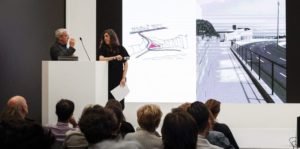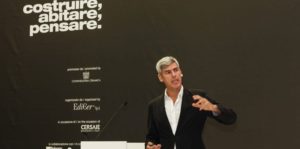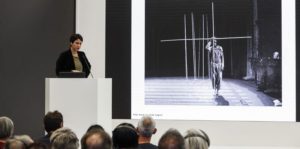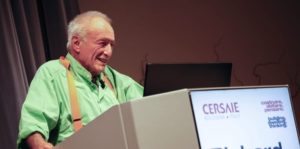Events


Spotlight on architecture at Cersaie | by Maria Teresa Rubbiani
This year’s Cersaie was attended by more than 10,000 architects and almost 2,500 interior designers, who travelled to Bologna to discover the many new ceramic products of high technical and aesthetic quality designed specially for use in architecture. Another factor prompting this large attendance was the range of cultural events organised specifically for architects as part of the “building, dwelling, thinking” programme, held for the tenth time this year. The conferences were attended by a total of almost 3,000 architecture professionals.
But the increase in attendance at Cersaie 2018 was not limited to architects, rising overall by 0.4% to 112,104 as a combined result of an increase in numbers of international visitors to 54,025 (+1.6%) and a slight fall in Italian visitors (58,079, -0.6%).
- Jean-Pierre Crousse and Sandra Barclay
- Camilo Rebelo
- Carla Juacaba
- Richard Rogers
The highlight of the “building, dwelling, thinking” programme was the Keynote Lecture given by Pritzker Prize Laureate Richard Rogers, held in the Europauditorium in front of a capacity audience of 1,800. The award-winning British architect and designer retraced many of the key steps in his career and discussed some of his most important projects and buildings, beginning with the iconic Pompidou Centre. “I was against it, but luckily the others were in favour. So I accepted the majority decision and we went ahead with it,” was how he remembered the origins of Beaubourg, dwelling in particular on the concept of the compact city. “If we don’t want to use our cars, if we want to talk to friends, the city must be compact,” he concluded.
Along with well-known guests from the world of architecture, Cersaie also hosted a number of events focused on specific themes. One of these was the conference entitled “The architecture of tolerance”, where Peruvian architects Jean-Pierre Crousse and Sandra Barclay gave a moving description of the project and the political and social conditions behind the creation of the splendid museum in Lima entitled “Lugar de la Memoria, la Tolerancia y la Inclusión Social” (LUM). The museum was built as a monument to a civil war that killed tens of thousands of civilians, many of whom were indigenous people from the Quechua communities, and which still divides Peruvian society today. The theme of tolerance was also explored by Sicilian architect Vincenzo Latina, who presented his project to redevelop a quarry in Lampedusa as a theatre for cultural events and as a memorial for migrants who died at sea, particularly the 388 victims of the shipwreck of 3 October 2013.
The other conferences welcomed emerging young international architects such as the Portuguese architect Camilo Rebelo and the Brazilian Carla Juaҫaba, along with well-known figures such as Mario Botta and Guido Canali. After illustrating a couple of their many projects (Botta presented two works carried out in his native Switzerland: the Fiore di Pietra restaurant on the summit of Monte Generoso and the project for the architecture theatre at the Università della Svizzera Italiana, while Canali presented three museums: the Palazzo della Pilotta in Parma, Santa Maria della Scala in Siena and the museum in Pontremoli), Botta and Canali engaged in a lively and very interesting discussion and concluded their conference with a shared vision. “Rather than imposing our own views, we must listen to the people who will live in the buildings and the surrounding areas,” Canali said. “If we start out from a position of arrogance, of pride, we betray our role.” Botta was in complete agreement: “I believe that humility is essential if we are to appreciate the tiny role we play in the construction of a landscape,” he said. “We measure ourselves against the earth’s crust, attempting to alter it, and in doing so reveal just how small we are.”
As for young architects, Carla Juaҫaba gave a brief overview of her work then focused on the project presented in the Vatican City Pavilion at this year’s Venice Biennale, where she designed one of the ten Vatican Chapels assigned to different internationally acclaimed architects. Camilo Rebelo likewise gave an overall presentation of his work then concentrated on his project for the Museu do Côa (Côa Valley Museum of Art and Archaeology). “The context is crucially important in my architecture, whether it is the natural landscape or the city,” he said. The museum is built in the middle of the Côa Valley archaeological park, where one of the biggest challenges in the design of the building was that of respecting the surrounding environment.
Alongside the conferences, the programme also featured a number of other initiatives of interest to architects. These included the Press Cafés, which hosted 13 conversations on themes of topical interest in the company of guests from the world of design and architecture; the exhibitions entitled “The sound of Design”, “Ceramics and Design” and “Mater Ceramica”; and the technical meetings organised as part of Tiling Town.
Look at the videos and video interviews of Cersaie 2018 cultural events.
October 2018







